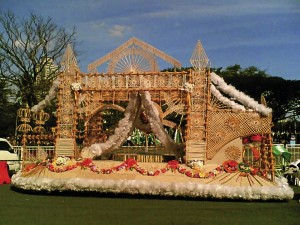
Just as easily as they party, Filipinos find an excuse to dance—for leisure or entertainment, as a manifestation of worship or as a social valve for relationships.
For this year’s Aliwan Fiesta—the 10th staging of the annual cultural extravaganza organized by Manila Broadcasting Co. and the Cultural Center of the Philippines in cooperation with the cities of Manila and Pasay—dance in its myriad forms once more takes centerstage, as interpreted in the festival context by contingents from various regions all over the country.
Craftsmanship
The Aliwan Fiesta also provides an excellent opportunity to celebrate Filipino craftsmanship and ingenuity, primarily through the float-design competition. Parades, after all, are an inherent part of the Filipino’s penchant for pageantry.
So when the nation’s most popular festivals converge in one single event, expect preeminent craftsmen in the different regions to bring out their most innovative ideas. Folk craft and décor are harnessed, and the best artisans tapped to design and execute the floats.
Four members of the elite jury who have been part of the Aliwan Fiesta celebrations since its inception in 2003 look back at some of the highlights of the festival’s first 10 years and rationalize how streetdance and float-making can be considered legitimate art forms in themselves.
Technical aspects
Nes Jardin, who was president of the Cultural Center of the Philippines when Aliwan Fiesta first took to the streets, acknowledges that the festival streetdance’s many forms are contemporary expressions but have that mandate to showcase something unique about their respective communities.
He recalls that there was a point when the pounding percussive beats made a lot of the routines look similar, but because of the wealth of dance traditions throughout the archipelago, and the use of traditional music infused with a lot of innovative instrumentation, each presentation took on its own cultural value.
“One’s judging outlook can be calibrated with the standard narrative, as with the Sinulog or Dinagyang,” says Jardin. “But it is more difficult with the Aliwan Fiesta because there are different kinds of festivals taking part. So, to level off on criteria applicable to all, we look at the technical aspects like precision, choreographic patterns, production design, and innovation, while at the same time determining whether the dance is culturally based.”
Call for excellence
CCP’s artistic director Chris Millado views the festival as reinforcing the center’s call for excellence. To him, Aliwan Fiesta is the best example of an art form that engages in a very broad way, especially when audiences see various communities coming together and participating in the process of art-making, while communicating their respective cultures through dance.
And with the perception that anything performed in Manila achieves national dimension, provincial groups that take part in the festival are motivated by the prospect of performing at the Aliwan Fiesta.
“In Aliwan,” explains Millado, “pictures change at the bat of an eyelash, the music seeps into your bones, and an empty street is transformed through color and wild revelry. This is what strikes at the heart of being Filipino with aplomb and style. So what do the judges look for? ‘Yung bongga!”
Heritage
Among the judges in the float-design competition, Eric Zerrudo of the University of Santo Tomas’ Center for the Cultural Conservation of Properties and the Environment gives the heaviest emphasis on cultural heritage. To him, Aliwan Fiesta is very much an enlightening educational experience for both the participants and the audiences who watch year after year.
It is a time to celebrate in a very grand manner, yes, but the festival gives everyone a chance to learn more about the rest of our fellow Filipinos—what they value, how they live.
“Amid the color and excitement, the tension, and the sweltering heat of summer, we get vivid images that will last a lifetime,” says Zerrudo. “The plethora of floats from Muslim Mindanao, for instance, with all that authentic Islamic décor from their royal houses, is something the ordinary man on the street won’t see every day in the mall. And the way Laoag showcases products like garlic in such a fabulously creative way is just—wow!”
Best part
Manila’s renowned floral architect, Rachy Cuna, says that the best part about Aliwan Fiesta is gaining an appreciation of how a town puts an entry together, whether as a dance or a float. The historicity, the details, and overall visual expression are so challenging, and yet each community delivers in an astounding and outstanding way.
“Aliwan Fiesta has gotten bigger and better every year,” says Cuna. “It represents our culture and our very lives. Through the intensity of the competition, we have to notice all the little details, yes, but at the end of the day, we see the heart of the Filipino people.”
Jardin, Millado, Zerrudo and Cuna will again be judging at the Aliwan Fiesta grand parade on April 14, and they all hope that audiences can look at the festival from the judges’ viewpoint to appreciate the efforts of the contingents better.
This year, there will be 21 streetdance participants and 22 floats, all battling it out in the grand festival of regional champions. Undoubtedly, it will be one big party.
And all the 5,000 or so participants will be extremely passionate about what they are bringing for Manila audiences to see—a celebration of their very lives.